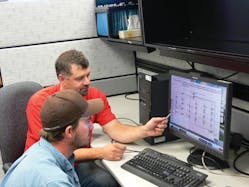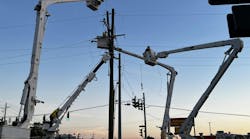Switching errors can be life-threatening, and as such, electric utilities are taking an active role in training their apprentices on proper procedures. Prior to obtaining their journeyman status, apprentices must know how to take a line out of service and re-energize it safely.
To educate apprentices about switching, trainers often give the apprentices a scenario with a paper map or schematic and ask them to write switching/operation orders. While this traditional approach has worked for many years, Manitoba Hydro is constantly researching new ways to train its apprentices through virtual technology. For example, the utility partnered with 3D Internet on the development of an overhead and underground distribution switching simulator.
Replicating the Utility’s System
About five years ago, Manitoba Hydro, the major energy provider in the province, purchased a transformer bank simulator from 3D Internet. From 2009 to 2010, the company worked with the vendor to develop a new program to aid the training of employees on distribution switching.
Because a plant can vary widely from one utility to the next, it was essential for Manitoba Hydro to personalize this training simulator. Most of its apprentices and journeymen only had experience working on their own utility’s system. For that reason, it was essential to tie the virtual training program in with their real-world infrastructure.
To replicate the utility’s plant inside the computer program, the vendor visited different substations and took many photos of regulators, automatic circuit reclosers and other pieces of apparatus. To help with this process, Manitoba Hydro had both underground and overhead experts assist 3D Internet with capturing the proper images.
Practicing Proper Switching
Once 3D Internet had all of the images, the vendor worked on creating the simulator for Manitoba Hydro. Manitoba Hydro employees have been using this program for about two years now, and they can access it from a laptop or desktop computer through the company’s corporate website. By clicking on the Trades Training department, they have a direct link to the simulator, and they can then download the program onto their computer.
Once they are ready to begin the program, they can select different pieces of equipment to take out of service such as an automatic circuit recloser, transformer, or a segment of overhead or underground line. They then proceed with the proper steps and select the correct answer through multiple choice. Next, they must return the cable, line or piece of apparatus back to normal.
The users can either select training or test mode. During the training mode, they can immediately pinpoint their mistakes. In the past, the instructors would correct the maps or operation order if the apprentices made a switching error. With the simulator in training mode, the user receives instantaneous feedback to keep them on the right track. Then, when they are in test mode, they have a better understanding of the correct procedures and can be more successful.
It typically takes about 10 to 15 minutes to complete a switching order in the module, which makes it easy for the apprentices to fit in practice time depending on their work location. The convenience of access allows the apprentices to work on the module while they are at the training center or at their respective work locations at the beginning or end of a work day.
Preparing Apprentices for Journeyman Evaluation
Manitoba Hydro was one of the first utilities to work with 3D Internet on a virtual training program for distribution switching, and as such, the company tried to make it as user-friendly as possible for the apprentices. The simulator requires only basic computer skills and no specialized training. The apprentices simply log on and then follow the steps until the end of the session.
Anyone who has access to the corporate website can use the simulator, but Manitoba Hydro recommends its fourth-year apprentices practice using the simulator to gain exposure in preparation for their journeyman evaluation.
During this exam, however, the apprentices do not use the simulator. It is a compentency-based training program, so they must showcase their skills in the field. For example, the apprentices must take the overhead and underground power lines out of service and then re-energize them at the yard at utility’s training center. By using the simulator for practice, the apprentices are able to get as close as they can possibly get to the real-life scenario they will face during their evaluation.
Many of the utility’s apprentices are young, and they like being able to visualize the switching on the computer rather than just writing down orders on paper. Through this technology, the utility has seen an improved distribution switching success rate at the journeyman evaluation. When they get out of the truck and operate the equipment during the evaluation, they have a better understanding of the proper steps to follow for switching such as what to do and what not to do.
While the training program is used mostly for apprentices right now, in the future, the utility will use the simulator as a post-journeyman training tool. Often, when apprentices successfully become journeymen, they don’t receive a lot of post-journeymen education. Manitoba Hydro, however, is progressively improving its post-journeyman training and the simulator is part of that program.
By offering the virtual training program to its field workforce, Manitoba Hydro’s goal is to make switching safer for everyone — from apprentices through journeymen. When taking out a section of cable or line or a piece of equipment, safety comes first. While the utility’s power line technicians always test for potential before working on a line, proper switching is still important, and it can help to prevent injuries or fatalities in the field and also assists in protecting the utility’s plant.
Chris Stasiuk ([email protected]), the senior line trades specialist for Manitoba Hydro, oversees the training and scheduling for the power line technician apprenticeship and its group of instructors.



